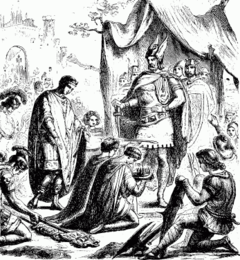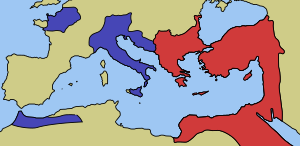
Romulus Augustus, nicknamed Augustulus, was Roman emperor of the West from 31 October 475 until 4 September 476. Romulus was placed on the imperial throne by his father, the magister militum Orestes, and, at that time still a minor, was little more than a figurehead for his father. After Romulus ruled for just ten months, the barbarian general Odoacer defeated and killed Orestes and deposed Romulus. As Odoacer did not proclaim any successor, Romulus is typically regarded as the last Western Roman emperor, his deposition marking the end of the Western Roman Empire as a political entity, despite the fact that Julius Nepos would continue to be recognised as the western emperor by the east. The deposition of Romulus Augustulus is also sometimes used by historians to mark the transition from antiquity to the medieval period.
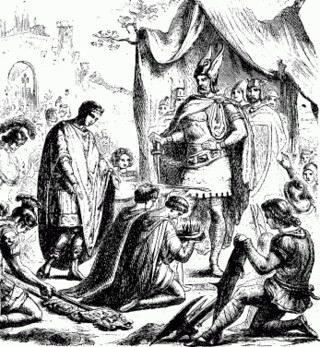
Year 476 (CDLXXVI) was a leap year starting on Thursday of the Julian calendar. At the time, it was known as the Year of the Consulship of Basiliscus and Armatus. The denomination 476 for this year has been used since the early medieval period, when the Anno Domini calendar era became the prevalent method in Europe for naming years.
The 470s decade ran from January 1, 470, to December 31, 479.
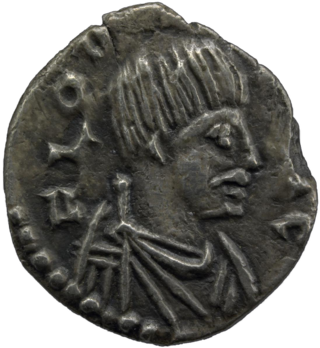
Odoacer, also spelled Odovacer or Odovacar, was a barbarian soldier and statesman from the Middle Danube who deposed the Western Roman child emperor Romulus Augustulus and became the ruler of Italy (476–493). Odoacer's overthrow of Romulus Augustulus is traditionally seen as marking the end of the Western Roman Empire.

Julius Nepos, or simply Nepos, ruled as Roman emperor of the West from 24 June 474 to 28 August 475. After losing power in Italy, Nepos retreated to his home province of Dalmatia, from which he continued to claim the western imperial title, with recognition from the Eastern Roman Empire, until he was murdered in 480. Though Nepos' successor in Italy, Romulus Augustulus, is traditionally deemed the last western Roman emperor, Nepos is regarded by some historians as the true last emperor of the west, being the last widely recognised claimant to the position.

Zeno was Eastern Roman emperor from 474 to 475 and again from 476 to 491. Domestic revolts and religious dissension plagued his reign, which nevertheless succeeded to some extent in foreign issues. His reign saw the end of the Western Roman Empire following the deposition of Romulus Augustus and the death of Julius Nepos, but he was credited with contributing much to stabilising the Eastern Empire.

The term Western Roman Empire is used in modern historiography to refer to the western provinces of the Roman Empire, collectively, during any period in which they were administered separately from the eastern provinces by a separate, independent Imperial court. Particularly during the period from 395 to 476 AD, there were separate, coequal courts dividing the governance of the empire into the Western provinces and the Eastern provinces with a distinct imperial succession in the separate courts. The terms Western Roman Empire and Eastern Roman Empire were coined in modern times to describe political entities that were de facto independent; contemporary Romans did not consider the Empire to have been split into two empires but viewed it as a single polity governed by two imperial courts for administrative expediency. The Western Roman Empire collapsed in 476, and the Western imperial court in Ravenna was formally dissolved by Justinian I in 554 AD.
Orestes was a Roman general and politician of Pannonian ancestry. He joined the court of Attila the Hun in his native Pannonia, in which he reached a high position, becoming one of Attila's most trusted men. Orestes also held considerable influence in the late Western Roman Empire. His son Romulus Augustulus became Roman Emperor of the West.

The fall of the Western Roman Empire, also called the fall of the Roman Empire or the fall of Rome, was the loss of central political control in the Western Roman Empire, a process in which the Empire failed to enforce its rule, and its vast territory was divided into several successor polities. The Roman Empire lost the strengths that had allowed it to exercise effective control over its Western provinces; modern historians posit factors including the effectiveness and numbers of the army, the health and numbers of the Roman population, the strength of the economy, the competence of the emperors, the internal struggles for power, the religious changes of the period, and the efficiency of the civil administration. Increasing pressure from invading barbarians outside Roman culture also contributed greatly to the collapse. Climatic changes and both endemic and epidemic disease drove many of these immediate factors. The reasons for the collapse are major subjects of the historiography of the ancient world and they inform much modern discourse on state failure.

The causes and mechanisms of the fall of the Western Roman Empire are a historical theme that was introduced by historian Edward Gibbon in his 1776 book The History of the Decline and Fall of the Roman Empire. Though Gibbon was not the first to speculate on why the empire collapsed, he was the first to give a well-researched and well-referenced account of the event, and started an ongoing historiographical discussion about what caused the fall of the Western Roman Empire. The traditional date for the end of the Western Roman Empire is 476 when the last Western Roman Emperor was deposed. Many theories of causality have been explored. In 1984, Alexander Demandt enumerated 210 different theories on why Rome fell, and new theories have since emerged. Gibbon himself explored ideas of internal decline and of attacks from outside the empire.

The Sciri, or Scirians, were a Germanic people. They are believed to have spoken an East Germanic language. Their name probably means "the pure ones".

The six-volume work The History of the Decline and Fall of the Roman Empire by the English historian Edward Gibbon (1737–1794) has been reprinted many times over the years in various editions.
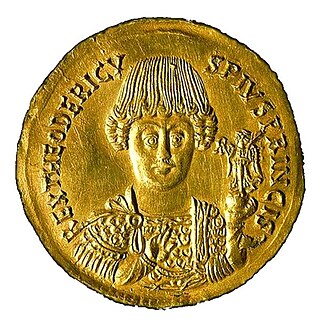
The Ostrogothic Kingdom, officially the Kingdom of Italy, existed under the control of the Germanic Ostrogoths in Italy and neighbouring areas from 493 to 553.
Ovida or Odiva was a late Western Roman general and warlord of likely Gothic origin and the last Roman ruler of Dalmatia. Ovida initially served Julius Nepos, ruler of Roman Dalmatia and later western Roman emperor in Italy from 474 to 475. After being usurped in 475, Nepos continued to claim the imperial title in exile in Dalmatia, supported by the Eastern Roman Empire, but he was murdered by Ovida and another general, Viator, in 480. Upon his death, Ovida became the ruler of Dalmatia, a position he held until he was defeated and killed by Odoacer, the first barbarian King of Italy, in 481 or 482.
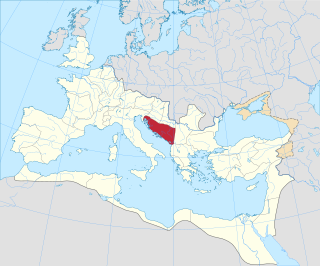
Dalmatia was a Roman province. Its name is derived from the name of an Illyrian tribe called the Dalmatae, which lived in the central area of the eastern coast of the Adriatic Sea. It encompassed the northern part of present-day Albania, much of Croatia, Bosnia and Herzegovina, Montenegro, Kosovo and Serbia, thus covering an area significantly larger than the current Croatian region of Dalmatia. Originally this region was called Illyria or Illyricum.

The Turcilingi were an obscure barbarian people, or possibly a clan or dynasty, who appear in historical sources relating to Middle Danubian peoples who were present in Italy during the reign of Romulus Augustulus (475–76). Their only known leader was Odoacer (Odovacar), but he was described as a ruler of several ethnic groups.

The Battle of Ravenna, capital of the Western Roman Empire, between the Heruli under their King Odoacer and the remnants of the Western Roman army in Roman Italy occurred in early September 476, and represented a culminating event in the ongoing fall of the Western Roman Empire. The Roman Empire had been in relative decline since the beginning of the barbarian invasions and Rome, the symbolical heart and largest city of the Western Empire, was sacked in 410 by the Visigoths and in 455 by the Vandals. By 476 the Roman emperor was little more than a puppet, having very little de facto control of any territory outside of Italy. The last Roman emperor, Romulus Augustulus, was not recognized as a legitimate ruler outside of Italy; the Eastern Roman Empire recognized Julius Nepos as the true Western Roman Emperor.
Anonymus Valesianus is the conventional title of a compilation of two fragmentary vulgar Latin chronicles, named for its modern editor, Henricus Valesius, who published the texts for the first time in 1636, together with his first printed edition of the Res Gestae of Ammianus Marcellinus. The two fragments are not related, one being from the fourth century and the other from the sixth. The only connection between the two fragments is their presence in the same manuscript and their history of being edited together. When Henricus' brother Hadrian re-edited the Anonymus in an edition of Ammianus Marcellinus in 1681, it was the first time that the two excerpts were clearly separated.

The Eastern Roman Empire was ruled by the House of Leo from AD 457, the accession of Leo I, to 518, the death of Anastasius I. The rule of the Leonid dynasty coincided with the rapid decline, collapse and eventual fall of the Western Roman Empire. Following the end of the Western Empire, Emperor Zeno abolished the position of Western Roman Emperor and declared himself the sole Roman Emperor. The Eastern Roman Empire would come to last for several more centuries, and subsequent dynasties would invest large amounts of resources in attempts to retake the western provinces.
The Battle of Ravenna was fought between supporters of Orestes and supporters of Julius Nepos for control of the Western Roman Empire. In prelude to the battle, Orestes had been ordered to raise a large army to confront tribal rulers in Gaul. Instead he led his force against emperor Julius Nepos in the capital Ravenna. Nepos was defeated and deposed, but managed to flee to Dalmatia. Orestes in turn enthroned his son Romulus Augustulus as Roman emperor. He was in turn overthrown by Odoacer in September 476 following the Roman defeat at Pavia.
